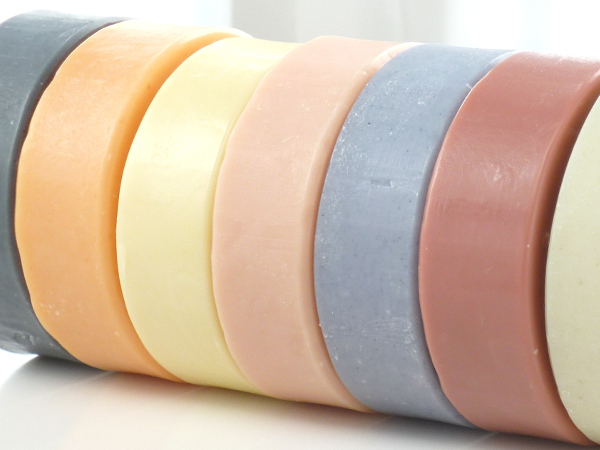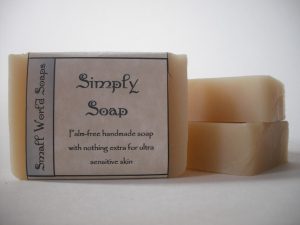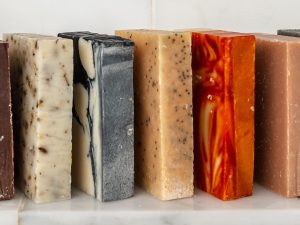True soaps can be made from a range of oils and butters which come from plants, trees and in the case of some oils such as tallow and lard, from animals. These oils and butters are chemically classed as mild acids. These mild acids are mixed with a strong alkaline (also called a base) that has been dissolved in water; such as sodium hydroxide, (also called lye -certain wood ash can be used to produce an alkaline too). You simply add precise amounts of the lye-water mix to the melted butters and oils at the right temperature and mechanically mix them all together. The acids and alkaline react together and neutralise each other into a salt; soap is the happy result and all the sodium hydroxide gets used up in the reaction. This beautifully simple reaction is called saponification. The 10 stage process in the illustration below shows the basic steps of small scale soap production.
A small-scale, cold-process production process

There are many ways to make soap: Making soaps just using the heat of the saponification reaction (no externally added heat) and without complex chemical additives is called the ‘cold process method.’ One of the advantages of this traditional production method is that all the natural glycerine (chemically bound to the oils and butters) remains in the soap (unlike many commercial bars that remove it due to its high value). The glycerine helps to soften, sooth and protect skin from drying out.
Natural soaps are often made in small batches to maximise freshness and are fully cured to ensure mildness. Quality natural soap makers use carefully selected blends of natural and moisturising ingredients that are found in nature for their active skincare qualities. Each of the oils and butters used brings a special set of characteristics desired in the soap; for example, coconut oil is called a gift by soap-makers worldwide due to its tremendous bubbly lather, cleansing qualities and highly emollient skin-softening qualities; olive oil is exceptionally mild and moisturising; shea butter contains a significant portion of natural material that does not turn to soap but remains in the soap to nourish, soften & soothe skin and also helps the soap form rich and stable bubbles; there are many more oils and butters to choose from (but no skin-irritating synthetic detergents, fragrances, dyes, colours, preservatives in sight).

Shea butter.
Natural colours
Natural soap colours come from skin conditioners such as natural cosmetic clays and plant materials. The advantage of using clays over many plant-based colours is that clays do not fade in light.

Top: Kaolin clay, reef red clay, indigo powder, charcoal powder (from coconut shells).
Scents from essential oils
The best quality natural scents come from aromatherapy-grade essential oils. These oils are extracted from a wide range of aromatic plants, trees and grasses and can be carefully blended using psycho-aromatherapy principles that can help to enhance moods and feelings; they smell amazing too!
One of the challenges of working with natural minimally-processed materials is the variation found in nature; natural materials vary depending on the area they come from and in the case of plants, the weather and growing conditions, the plant variety used etc, this makes each bar of soap made this way totally unique. Another difficulty is that the scent of some essential oils is changed in the saponification reaction so oils have to be chosen with great care. Preservation without artificial preservatives is also challenging; there are a number of options such as rosemary oleoresin extract and tocopherol (vitamin E). Interestingly, oxidised soaps are still perfectly safe and effective to use, but they may not look so attractive when spots appear on them. In commercial production quality control at all stages of the production process is very important.

Combinations of essential oils are used to create scent blends.
The surprising story of how soap was first discovered
While the first records of practical soap making go back to about 2500BC, there is a more modern and charming story around a thousand years old about women rinsing clothes in the river Tiber at the base of Mount Sapo near Rome (sapo means soap in Latin). Animals had been sacrificed in fires burning a little higher up the hill. The women noticed how the clothes became cleaner as they made contact with the soapy clay sliding down the hill into the water. A reaction between the acidic animal fat from the sacrifices and the fire’s alkaline wood ashes in water caused a primitive soap to form. Cooked (rendered) animal fat and processed wood ashes are still used to make soaps in many places today.
Whether or not the story stands up to scrutiny the fundamentals of how soap is formed still hold true.
The amazing way soap cleans
Counter-intuitively, water alone does not wet things very well. Soap helps break water molecules apart and makes the water wetter and more able to soak in; soap here is acting as a surfactant.
Soap has some truly amazing characteristics; the soap molecule has a head which attracts and is attracted to water and a tail that repels it. However, the tail is attracted to and attaches to dirt; the head pulls the tail (& dirt) away from hands, body, clothes or whatever you are washing and the molecule suspends itself in water until a rinse carries the dirt away down the drain – job done!
What are the benefits of natural soaps?
Synthetic bar soap manufacturers (not soap at all, but a detergent) may make many claims about how their products match natural skin pH and natural soaps do not (a controversial and complex subject) and liquid soaps may be convenient and cheap, but many chemicals are used in their manufacture in order to give them the right consistency, make them smell agreeable, produce copious lather and not to block the dispensers (in the case of liquid soaps). Harsh synthetic chemicals go on your skin (the largest organ in your body) and into the environment and the more we use them the more gets made and the more synthetic chemicals get on to our skin and washed into the environment in a vicious cycle. True soaps are tried, tested and trusted as they have been used for thousands of years without problems.
Ideally, a natural bar of soap will have a larger number as well as a careful combination of high-quality oils and fats that bring a special set of characteristics with them to the soap, as well as a whole range of carefully researched essential oils, mineral clays and plant botanicals. Have a look at the ingredients in a quality bar of a natural soap and compare them to other ingredient labels of commercial beauty bars and see the differences.
Business: the gentle way
When we started Gently Handcrafted Ltd we felt the need to follow a different path to the business models we had seen operating in too many industries. We worked incredibly hard to make sure we use the best ingredients we could find, using organic oils that are great to put on your skin and combined in the most beneficial way. We went to the nth degree to ensure that the processes we use, the products we create and the packaging are re-useable, recyclable or bio-degradable with nothing to throw in the waste bin, or as we like to say, “gentle to skin & Earth.” We also wished to be as honest & transparent as we could. All the claims we make concerning; our processes, the information we provide about ingredients & products, as well as our reasons for operating Gently Handcrafted the way that we do, are referenced & verifiable as far as possible. We spent three years creating a range of products processes and packaging we are happy to use ourselves, use on our three children & happy to share. Why did we go to all this effort? Because we believe that businesses should put humans, animals and nature at front and centre of everything they do. Working together towards equality and diversity, by treating people and the environment with respect, dignity and love; ensuring a sustainable future for us all in a healthy environment.

The River Wye seen form Symonds Yat Rock close to our office.
We are currently only small scale and at the start of our journey, but see it as a privilege to be able to make products that contribute to the well being of others and the environment and to work with what we feel passionate about.
What can you do about making your own soaps?
If you’d like to make home soaps there are some good books to be found here and an online course here. Be warned that producing soaps commercially for sale is a vastly different, more complex and very competitive undertaking. If you would like to find out more we are here for you! You can drop us a line to: [email protected]
Martin & Monica Neicho of Gently Handcrafted Ltd. Martin has been involved with nature, the environment and the organics industry since 1991 and is a qualified horticulturist. He and Monica have been making soap since 2010. As well as raising a family, Monica has a passion for art and natural living, she is a self-taught artist and illustrates GH soap labels. Gently Handcrafted sell a range of high quality organic handmade soaps with classic and illustrated labels that can be customised to order, as well as other cosmetic related items; available at: www.gentlyhandcrafted.co.uk.
Martin and Monica are currently producing and testing effective natural home cleaning and laundry products for a new blog that provides easy instructions on making safe to use, cost effective cleaners that are better for health, the environment and should cost between 30%-50% of store bought products when made at home: Watch this space!





